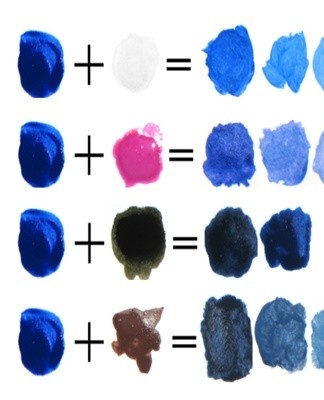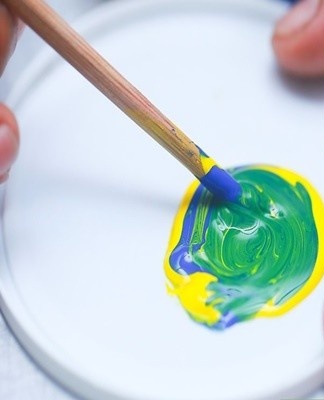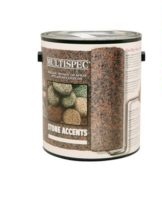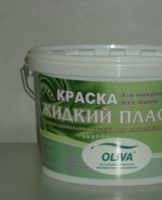How can you get blue by mixing paints and a chart of the 8 best shades
The sparkle of ocean water, the dark shadow of the evening sky, all this is the blue that has attracted a person throughout the history of the Earth. Many talented artists have managed to convey this beauty in their paintings. At the same time, people who first took a brush for painting in their hands or began to decorate an interior are often interested in the question of how to get a pure blue color when mixing paints.
Theoretical knowledge about the color blue
It has long been customary to divide colors into warm and cold. The hot ones are those that are characteristic of summer, the cold ones are more frequent in winter. Blue is the coolest color in the spectrum. The blue painted walls evoke a feeling of austerity and freshness. There are 3 main colors, in addition to white and black, combining them, artists achieve a variety of shades:
- Red.
- YELLOW.
- Blue.
They are said to be clean and cannot be obtained by mixing paints. By combining them, you can get secondary colors. These include: orange, green and purple.
Interesting: light waves have no color. It depends on the perception of the light wave by human eyes and brain. Some people see letters in words or numbers in different colors. Tones are individual for each person. This phenomenon is called synesthesia.
People associate blue with professionalism, reliability, designers know this well and often use its combination with white when designing websites and logos.
How to get blue by mixing paints
The base pigments must be present in the palette. They cannot be obtained by mixing, since it is never possible to highlight a clear and pure tone. Let's see what paints and why it is convenient for a novice artist to use.
Watercolor
It is found on the children's table and in the studio of the venerable artist. It appeared more than 600 years ago. Painters of that time carefully guarded the secrets of creating persistent color pigments. In the 18th century, watercolor was first sold in European stores. This made drawing lessons accessible and popular.

Watercolors are composed of a coloring pigment and a water-soluble adhesive additive. The use of gum arabic and dextim, transparent vegetable glues, allows the paint to adhere well to the paper. Honey is often used as an adhesive component. Glycerin and sugar syrup serve as plasticizers, protect paints from drying out and cracking.
Watercolor is harmless, diluted with water and allows you to create bright drawings and delicate paintings in which color is indicated only by a hint. The paints are odorless, miscible with water in any proportion.The more water you have, the fainter the print will be. You should paint in watercolor, going from a light tone to a darker one. White watercolor paint is used to obtain light shades, it is not used for painting, since the white fragments of the drawing are not painted.
To obtain light azure or blue tones, the base is bleached, the whiter the pigment, the lighter the shade. To darken the tone, black is added to the main color. It is introduced carefully, comparing the resulting shades on the palette.
Gouache
Gouache is characterized by high density and opacity. It does not spread on the surface, it has a good covering power. Gouache can be applied on glass, tiles, wood. Paint, like watercolor, is odorless and can be diluted with water. It can be easily washed from surfaces and washable from materials. It dries quickly, is non-toxic, so it is often used for children's art. In composition, watercolor and gouache are the same, but in the latter there is more color pigment and an adhesive base. When dry, the gouache becomes a little lighter, the drawings made with this paint appear more textured.

Stir the gouache well to even out the tone created. Gouache can be used on white and colored paper due to its density. To add shine to gouache designs, use sugar water when painting. By mixing blue and red gouache you can get different shades of purple and lilac; adding lime or black to it - to make the tones lighter or darker than pure color.
How to get blue from different colors
So you can't get pure blue by mixing other colors, but you can get interesting new shades of azure by combining blue with other colors.
Green
When blue and yellow are mixed in equal proportions, green is obtained. Adding a touch of green to the base results in a turquoise blue, which can be brightened by adding white. By mixing blue, green and black, you can get different shades of dark blue. For example, royal blue or navy blue.
YELLOW
The mixture of yellow and blue colors gives different shades of green. A drop of yellow in a blue base produces a blue-green tint. The mixture of blue and bright yellow results in tones ranging from green and turquoise to olive and light green tones.

red
Adding red to the base tone gives different shades of magenta and purple. Mixing blue and pink produces lilac or lilac. When mixed in equal proportions of red, blue and yellow pigments, a black color appears on the palette.
Features of obtaining different shades
Let's try to get different variations based on pure tone.
Blue
White should be added to blue until the desired shade is achieved. If you need a very light tone, it is better to do the opposite, add blue to white drop by drop.
blueberry
To get this shade, artists advise adding purple to the main shade and dripping red-brown and black.
Navy blue
The main color is made darker by adding a drop of black paint to it.
Indigo
Also achieved by adding black to blue paint until desired tone is achieved.
Grozovoy
The mixture of azure and brown or gray gives such a shade. To make it lighter, white is mixed in if necessary.

Sapphire
A very difficult color, as the gem that gave the color its name can be blue to almost black in color. Adding a pink color to the base of the drop will ensure a sapphire hue appears on the palette.
Cobalt
Cobalt blue in art paint sets is the primary color from which all others are derived. Cobalt dries quickly and has excellent surface coverage.
dark blue green
To get this shade, you need to mix blue, green and a drop of black.
blue shade table
What color will be obtained by mixing several pigments:
| main color | Additional | The result |
| Blue | white | Blue |
| A drop of purple + a drop of brown + a drop of black | blueberry | |
| Black | Navy blue | |
| Black | Indigo | |
| Brown or gray drip | Grozovoy | |
| Pink | Sapphire | |
| cobalt blue | It is the base color of most paint kits. | |
| Black | Navy blue |
Often the shade of the base color is first bleached to the desired intensity and then mixed with an additional color palette.
With a set of 5 basic pigments you can create many color combinations, but of course this does not mean that you have to give up sets with a wide palette. After all, they allow you to quickly achieve the desired tone or start creating as soon as inspiration strikes.



